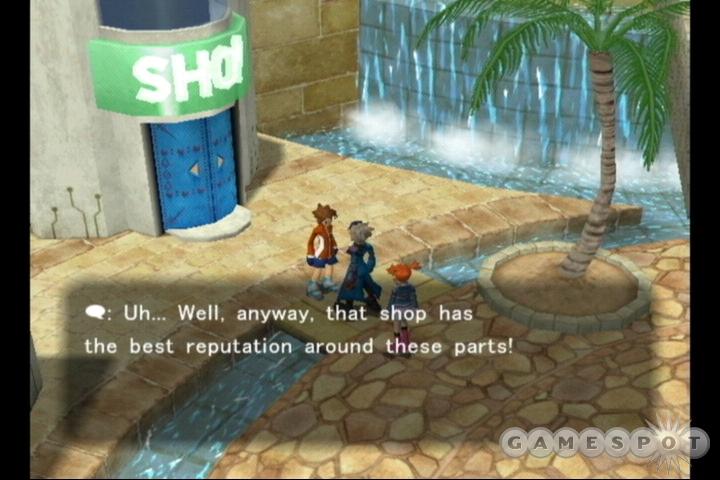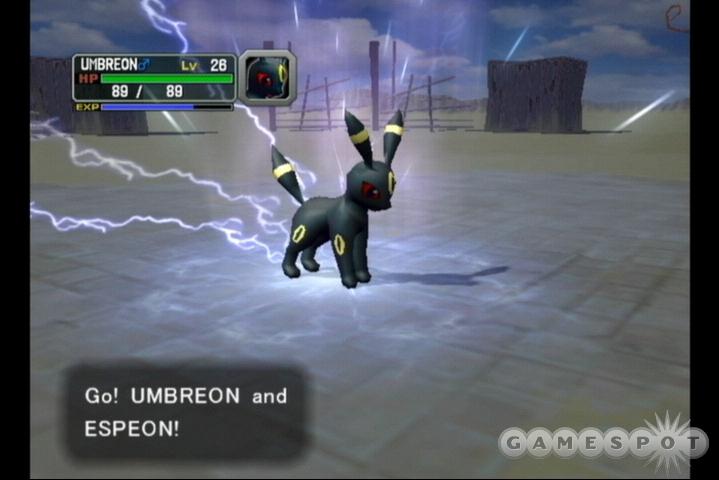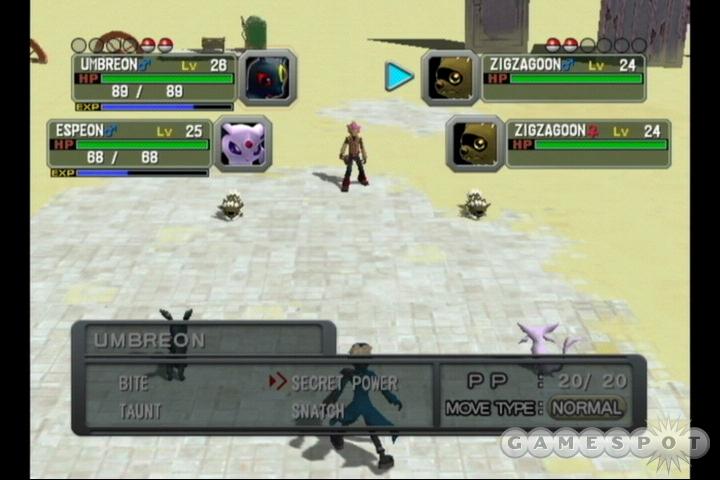Pokémon Colosseum Preview
We take a long look at the US version of Nintendo's GameCube Pokémon game.
Pokémon Colossuem is the long-awaited GameCube installment in Nintendo's Pokémon franchise. The game follows in the footsteps of Pokémon Stadium on the Nintendo 64, which let you use data from your Game Boy Pokémon games to duke it out with friends in full 3D. However, rather than simply serve up a carbon copy update of Pokémon Stadium, Nintendo and developer Sonority Genius have offered up a unique game that blends the familiar competitive aspects of Pokémon Stadium with a full-fledged single-player RPG. The title, released earlier this year in Japan, is effectively two games in one. As a result, it's been wholeheartedly welcomed by fans there. We recently had the chance here to take an exclusive look at the US version of the game to see how it's made the jump to the American market.

While similar in spirit to the Nintendo 64's Pokémon Stadium, Pokémon Colosseum features some significant differences that ensure the game offers a unique and engaging experience. The most obvious is the game's focus, which has been broadened to include a single-player component in addition to the expected multiplayer battles. Pokémon Colosseum offers two main modes to choose from--story and battle.
The story mode is essentially a full-blown single-player 3D RPG that has a bit of fun with the now-familiar setup for the Pokémon games. Pokémon Colosseum offers a darker premise that presents an interesting contrast to the typically lighter touch of the GBA games. You'll be cast in the role of a teenaged member of a gang who starts the adventure by staging a spectacular prison break for his two trusty Pokémon, Umbreon and Espeon, from the confines of a gang hideout in the arid Orre region. Shortly after liberating your friends, you'll rescue a young woman who offers up some disturbing information on a mysterious bunch of Pokémon, called shadow Pokémon, that are starting to appear. The new breed of aggressive critters are ordinary Pokémon whose hearts have been closed off, thus resulting in some dangerous--and often uncontrollable--behavior. You'll team up with your new ally to discover just what's creating shadow Pokémon, and you'll also liberate the poor creatures--with the help of your companion's ability to spot them.
The battle mode is a straightforward assortment of multiplayer components and Game Boy Advance connectivity that lets you and up to four friends fight with your roster of critters from Pokémon Ruby and Sapphire. You'll find two main modes, colosseum and battle now, that feature unique variations. Colosseum will feature solo and gang battles for your participation. Solo battle will offer colosseum battle, which is a sequential duel against eight consecutive trainers in different stadiums that feature different restrictions. Solo battle will also offer "mountain battle vs. 100," which is a pretty brutal survival-style series of battles against 100 trainers that sees you literally working your way to the top of the heap. Gang battle is a two-to-four-player multiplayer game for two or four players that lets everyone pit his or her GBA Pokémon against each other. You'll be able to play as the main characters from the story mode or as the leads from Ruby and Sapphire on the GBA in customizable matches that let you use stock Pokémon in addition to your minions. The battle now game is a quick match you jump into, after just a few choices, for some quick no-nonsense dueling.

As you'd expect, Game Boy Advance owners will be able to use data from Pokémon Ruby or Sapphire games during the competitions, and once finished with the single-player RPG, players can trade Pokémon between the GC and GBA. You'll also find a nice selection of secrets and useful items, some of which you'll have to discover and others of which you'll have to purchase with pokécoupons, the game's currency.
As far as gameplay goes, Pokémon Colosseum features two distinct types of gameplay. The single-player RPG uses a pretty typical third-person perspective, with a fixed camera during the segments where you'll be on foot exploring towns. The game doesn't handle like a simple 3D upgrade of the GBA games due to a number of subtle changes to the formula. You'll still travel to different towns to interact with the locals. However, this time, travel between locations is done via an overworld map that lets you highlight a destination. Rather than head there on foot, you'll be treated to a cinematic that features you riding a futuristic set of wheels. As a result, you won't have any random encounters with wild Pokémon. This fits the game's new approach to adventuring, since you won't be catching wild Pokémon on your quest.
Your quarry in Pokémon Colosseum will be the aforementioned shadow Pokémon. In a rather dramatic departure from the polite, rule-based setup of the GBA games, Pokémon Colosseum will require you to "snag" your opponent's Pokémon during battle. You'll know which creatures to target at the start of a fight because your companion will single out which of your opponent's fighters are shadow Pokémon. Once you catch them, you'll be able to use them in battle, but their dark condition affects their abilities. The dark Pokémon will only have access to a "shadow rush" attack that causes them to take some damage each time it's used.

To unlock your shadow Pokémons' full abilities, you'll have to "purify" them by opening their hearts. You'll accomplish this "deprogramming" by using them in battle and by using items. A bar onscreen will decrease as the Pokémon are purified. As the bar goes down, more and more of your critter's abilities will become available. To fully purify a Pokémon, you'll have to perform a ritual in a special location that will replace the shadow rush attack with what is usually your Pokémon's most powerful attack.
The second type of gameplay in Pokémon Colosseum--combat--pops up in both the single-player and multiplayer games. Battles will play out in the same basic turn-based fashion as the GBA game, so Pokémon Colosseum will use essentially the same combat system as Ruby and Sapphire, although there will be a greater emphasis on two-on-two combat.
The graphics in the game are solid, albeit a bit more modest than we'd hoped for. The overall look of both modes in the game is a distinct change from the lush world of the GBA games. The land of Orre is pretty barren and relies on a lot of browns to bring its bleak deserts to life. Fortunately, the towns and other environments you'll be going through offer quite a bit of variety in their appearances. The resulting variety makes up for the sandy and plain look of Orre on the overworld map and traveling segments. The towns are a patchwork mix of locales that all feature unique looks with little flourishes, such as running water or foliage. The Pokémon are all modeled with a minimalist eye to detail that capably updates their 2D designs without being too showy. The menagerie you'll use and encounter on your travels all look and animate well in combat. Speaking of combat... You'll find the effects used during battles offer a solid, albeit slightly limited, collection of visual tricks to represent the various attacks. While the game isn't a graphical powerhouse, it still manages to maintain the expected Pokémon charm.

The audio in the game is fairly low-key, despite the GameCube's muscular sound hardware. The strongest element of the audio package seems to be the soundtrack, which is a well orchestrated assortment of familiar and original tunes that accompany battle and exploration. The actual sound effects in the game take the same basic approach. You'll hear a lot of familiar effects from the Game Boy Advance games, most of which have been upgraded in some way. The weakest element in the audio package involves the cries of the various Pokémon, which are (sadly) a little too close to their GBA game incarnations and lack the punch we'd hoped for.
Despite a lack of polish and some rough edges in spots, Pokémon Colosseum looks as though it's just what the doctor ordered for Pokémon fans. The multiplayer aspects of the game cover the right bases, and the single-player game is a strong, though linear, addition to the package. The game is currently slated to ship next week, so check out our upcoming full review for the final word on Pokémon Colosseum.
Got a news tip or want to contact us directly? Email news@gamespot.com
Join the conversation